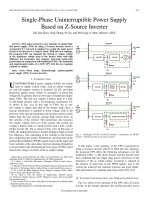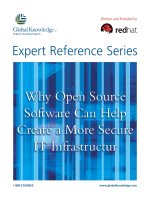Deploying business virtual appliances on open source cloud computing
Bạn đang xem bản rút gọn của tài liệu. Xem và tải ngay bản đầy đủ của tài liệu tại đây (549.45 KB, 5 trang )
International Journal of Computer Science and Telecommunications [Volume 3, Issue 4, April 2012] 26
Journal Homepage: www.ijcst.org
Tran Van Lang
1
and Nguyen Trong Duc
2
1
Institute of Applied Mechanics and Information Technology (IAMI/VAST)
2
Post and Telecommunications Institute of Technology, HCMCity
1
,
2
Abstract– The Cloud computing emerges as a new
computing paradigm which aims to provide reliable,
customized and QoS guaranteed dynamic computing
environments for end-users. Virtual machines (VMs)
provide a virtualization solution to the security and
resource management issues that arise in isolated
environment. We encounter the need to deploy an open
source cloud computing and integrate VM (a virtual
business server) with business applications into cloud
models and the existing resource management
infrastructure. To address such requirements, the paper
describes an approach to deploying business virtual
appliances on Open-source Scientific Cloud computing
based on the Globus Virtual Workspace Service (Nimbus
project) as an Infrastructure as a Service.
Index Terms– Cloud Computing, Grid Computing,
Virtualization, IaaS and Virtual Appliance
I. INTRODUCTION
Recently, cloud computing [1] has been under a growing
spotlight as a possible solution for providing a flexible, on
demand computing infrastructure for a number of
applications. Cloud computing is recently offered by
companies like Google, IBM [2], Amazon [3], and Sun, etc.
With increasing demand from business for higher efficiency,
productivity, business agility, and lower cost, for several
years, information communication technologies (ICT) have
been shifting dramatically from static local environment with
manually managed resources and applications towards
dynamic virtual environments with automated and shared
services with service-oriented architectures. In order to find
other computing infrastructure solution for the flexible and
effective computing resource for enterprises, one of solution
that has come recent years is cloud computing.
The research try to deploy an internal or private cloud
similar to Amazon EC2/S3 services that provide
Infrastructure as a Service (I-a-a-S), it means a set of virtual
servers that work together through the Internet and can be
dynamically managed, monitored, and maintained. Users are
expected to develop their own virtual images or use existing
ones as an executable environment on the cloud. Using
virtual machines (VMs) that can be configured before
deployment has the potential to reduce inefficient resource
allocation and excess overhead. A VM can create an
environment on a resource that is configured independently
from that resource, allowing multiple such environments to be
deployed on the same resource at the same time. In this
manner of separation, each environment is kept secure from
any others. Because sharing can be much more flexible, this
also can also increase resource utilization [4].
The approaching of this research was focused on open
source grid computing, cloud computing and virtualization
technologies. That approach based on the grid computing
middleware Globus Toolkit-4 [15], Globus Virtual
Workspace service [5], Virtual Machine Monitor (VMM) Xen
Hypervisor [6], and some networking technologies on Linux
OS (Ubuntu Server). In addition, I also tried to deploy some
configured virtual machine images as virtual appliances with
some popular business applications that run on open source
environments with Linux OS, Apache Web Server, MySQL,
PosgreSQL RDBMS, PHP or JAVA.
The main goal of this work was to test the applicability of
science cloud computing to business application environments
that are usually run on the local resource computing or private
IT infrastructures.
The remainder of the paper was organized as follows.
Section 2 presents the approach methods to solve problem. In
section 3, the experimental environment was presented. Then,
some conclusions and evaluations were given in final section.
II. APPROACH
This approach relied on implementing the Globus
Workspace Services for IaaS cloud that enable resource
leasing with VMs and deploying business applications which
based on the configured VMs or virtual appliances.
A. The Use of Virtual Machine (VM) Technology to
Implement Virtual Appliance
VMs present the image of a dedicated raw machine to the
business application; Virtual appliance is a configured VM
from the operating system to the applications and the use of
VMs for business application becomes more common. A
Deploying Business Virtual Appliances on Open Source
Cloud Computing
ISSN 2047-3338
Tran Van Lang and Nguyen Trong Duc 27
configured VM can be deployed on many different sites or
hosting machine without requiring the resource providers to
understand the application and its dependencies. An
application running on a VM is decoupled from the system
software of the underlying host machine.
VMs also enable resource allocation for specific business
jobs or applications. It is hence feasible to restrict the
memory, network, disk size, and even the CPU cycles
allocated to a given VM. Furthermore, the use of VMs allows
the target execution environment for a business application to
be completely customized, thereby enabling support for jobs
with special requirements like root access or legacy
dependencies. VMs also enable process migration without
requiring any modification or re-linking of the business
application.
B. Globus Virtual Workspace Services
Virtual Workspaces (VW) are described by workspace
metadata (XML Schemas), which contains all the information
needed to deploy a workspace in various contexts. An atomic
workspace, representing a single execution environment,
specifies the data (e.g., VM images) that must be obtained
and deployment information (such as networking setup)
that need to be configured on deployment. At deployment
time, a workspace is associated with a resource allocation,
which describes how much resource (CPU, memory, etc.)
is assigned to the workspace.
Globus Virtual Workspace Services (VWS) [5]is a Globus
Toolkit 4 (GT4) [15]component based service used to
deploy workspaces. The Workspace Service implements a
WSRF-based protocol allowing remote clients to start, stop,
manage, and query the workspaces. All client actions are
authorized using the Grid Security Infrastructure (GSI). VWS
functionality is exposed via web services implemented in the
GT4 container. Providing essential functionality are the
Workspace Factory Service, for generating new workspaces;
and the Workspace Service, for managing existing
workspaces. The Workspace Client communicates with these
services, to authenticate users and control virtual workspaces.
VWS maintains an internal resource list of worker node hosts
(each available node is identified as a resource slot), stored in
the workspace persistence database.
Currently, Xen Hypervisor [6] is the main VMM available
to use with VWS. Xen is a software process that manages the
hardware resources of the real machine among instances of
VMs, thus allowing multiple instances of VMs to run
simultaneously on the same hardware. Xen requires source
modifications to guest operating systems to run them in a
hypervisor.
C. Virtual Workspace Service Interactions
Assume that the Workspace Service executes on a service
node of a physical cluster and provides a secure gateway to
a set of resources that can support the deployment of virtual
machines. All VM images necessary for deployment has
already been staged to a node in the trusted computing
base (TCB). The service node of the physical cluster runs
a GT4 container and the Workspace Service. The hosts are
configured with the Xen hypervisor, Workspace Service back-
end scripts and some means of transferring image files and
other data relevant to the workspace from within the TCB.
To deploy a VW on a specific resource, a client contacts a
VW Manager Grid service on that resource and presents it the
workspace’s end-point reference (EPR).In order to create a
workspace instance, a Grid client contacts the VW Factory
with a workspace description. A negotiation process may
take place to ensure that the workspace is created in a policy
controlled way. The newly created workspace is registered
with a VW Repository, which provides a Grid service
interface allowing for inspection and management of
workspaces and keeps track of resources implementing
workspaces such as virtual machine images. As a result of
creation the client is returned a WSRF EPR to the workspace.
The Workspace Service maintains a database of
information about physical hosts available for workspace
deployment. For each physical host it records availability,
CPU type, total/available memory size, total/available disk
size, and system information. When the Workspace Service
receives the workspace creation request, it searches the
database for a set of resources matching the resource
allocation request, defines a matching set, marks it as
reserved, and maps the resource allocation onto it. When the
workspace is terminated, the resources are reclaimed and
the database is modified accordingly.
In addition to allocating resources, the Workspace
Service also handles local IP address allocation. The first
step of workspace deployment involves propagating the
images to the target nodes: workspace scripts executing on
each node download the images from a specified location for
pre-staging of the images without actually starting the VMs.
The back-end scripts work with the Xen hypervisor and
complete the configuration of the workspace. Configuration
information that cannot be processed by Xen (such as
networking) is set up by calling an OS boot script
preinstalled in the VM images.
After a workspace is deployed, a program can be started by
using Grid infrastructure mechanisms (e.g., Globus Resource
Allocation Manager, or GRAM) or by using other methods
such as preconfigured program startup or a continuation of a
previous execution. The VW Manager can also stop, pause, or
undeploy a stopped or paused workspace by invoking start
and stop operations with different parameters [7].
III. EXPERIMENTAL SETUP
First we need to build a science cloud using the Globus
Virtual Workspace (or Nimbus Toolkit project) in our testing
environment and then try to deploy some virtual appliances
that will run business servers have configured applications.
Some installation manuals reference to Globus Toolkit 4
Installation Guide, Nimbus Administration Guide [8], and
Ubuntu Server Guide [9].
A. Testing Environment
Experimental environment is a simple private cloud model
with some networked physical servers which were setup one
head node, one cloud client node and four worker nodes. Most
of nodes must be installed a stable and long term support
International Journal of Computer Science and Telecommunications [Volume 3, Issue 4, April 2012] 28
version of Linux Ubuntu Server 8.04.3 LTS (Hardy Heron),
On cloud client node can be used linux desktop with graphic
user interface. All worker nodes must be installed VMM –
Xen Hypervisor 3.2 with Xen OS kernel and DHCPd service.
Password-less SSH and NFS were configured within these
servers to allow automated file transfers and remote command
executions. The nodes were time-synchronized using NTP as
required be Globus Virtual Workspace. Fig. 1 shows the
network diagram of testing environment and Table 1 shows
the characteristics of machines I used in my experiments.
Fig. 1: The network diagram for testing private cloud computing
Table 1: The characteristics of physical servers in testing environment
Node Name Hardware Configurations Networks Role
Grid-HN
CPU Core 2 dual 2.2 GHz, RAM 512MB, HDD 04GB, 02
NIC
192.168.0.130
(private NIC)
192.168.100.130
(public NIC)
Head Node or VW
Service Node.
Grid-WN1
CPU Core 2 dual 2.4 GHz, RAM 02GB, HDD 250GB, 01
NIC
192.168.0.131
Worker or
Resource Node.
Grid-WN2
CPU Core 2 dual 2.4 GHz, RAM 02GB, HDD 250GB, 01
NIC
192.168.0.132 Worker Node
Grid-WN3
CPU Core 2 dual 2.4 GHz, RAM 02GB, HDD 250GB, 01
NIC
192.168.0.133 Worker Node
Grid-WN4
CPU Core 2 dual 2.2 GHz, RAM 512MB, HDD 04GB, 01
NIC
192.168.0.134 Worker Node
Grid-Client
CPU Core 2 dual 2.2 GHz, RAM 512MB, HDD 04GB, 01
NIC
192.168.0.254 Cloud Client Node
Network Configurations:
Gateway: 192.168.0.1
Subnet Mask: 255.255.255.0
Primary DNS: 192.168.0.1
Secondary DNS: 192.168.0.1
Domain: grid-hn.mycloud.com
IP arranges for VMs 192.168.0.151 ~ 192.168.0.160 = 20 IPs.
B. Science Cloud Computing Installation with IaaS Model
Several tools were used to set up this experiment, the first
of which are the Globus Toolkit 4.0.8 (stable version that is
compatible with current using linux version Ubuntu Server
8.043 LTS), Virtual Workspace Service TP2.2 and
Workspace cloud client 1.4 [7]. The Virtual Workspace
Service is installed on a Grid architecture which was aim to
create the science cloud, and allowing users to create virtual
environments using the workspace cloud client that allows a
user to upload virtual machine images, download, modify,
delete, or save copies of preexisting images, and deploy
images as virtual machines. In addition, there were many
linux networking tools and system services need to be
installed and configured in order to match all system
requirements such as NFS, DHCP, RFT (Reliable File
Transfer), GridFTP (a high speed transfer service that expands
the File Transfer Protocol to include features needed for Grid
computing applications), GSI–X509, Password Less-SSH,
Xen VMM as well as Java & Python runtime. Before any
workflow could be run on the science cloud, the appropriate
above softwares and toolshad to be installed and configured
on the experimental environment [8].
Tran Van Lang and Nguyen Trong Duc 29
In the following layout, the paper describes the layout of
science cloud computing model with Infrastructure as a
Service. In this architecture, there was one node for virtual
machine disk image repository which will store all cloud
user’s VM images. The specific requested VM image will be
transferred to resource worker node and then will be taken by
Xen Hypervisor in order to boot the VM’s guest operating
system. The physical cluster head node, was installed with
Globus virtual workspace service, was as a GT4 Web service
interface which receive all virtual workspace deploying
request from virtual workspace clients node(s). The steps
were taken by the VM-based GVW science cloud model to
establish a virtual machine session for a user as follows (refer
to Fig. 2):
Fig. 2: Science cloud in experimental environment with IaaS Model
The diagram above depicts the basic steps: (1) A special
workspace client called the "cloud-client" invokes workspace
deployment operations on the cluster head node service; (2)
Files are transferred from the cloud-client to a client-specific
directory on the repository node (RFT or other types of
GridFTP based transfers); (3,4) The service invokes
commands on the VMMs to trigger file transfers from the
repository node; (5)The VM instance is running in Xen
DomU and startsits lifecycle events, if the workspace state
changes, the cloud-client will reflect this to the screen (and
log files) and depending on the change might also take action
in response. User can access and control the VM via SSH
Telnet login session, or a virtual display session such as VNC.
C. Virtual Business Servers Deployment
Our built cloud computing in the above test environment
are resources for the IT computing infrastructures, we need to
build some VM images which are fully configured images
(virtual appliance) with installed business applications, and
coordinate the mapping of virtual appliances onto those
available resource platforms. We can create the virtual
appliance by ourselves or buy from appliance providers.
Some popular appliance providers such as VMWare [10],
JumpBox [11], TurnKey [12] or BitrixSoft, provided fully
customized virtual appliances (disk images) that will launch
them in the cloud or computing environment that supports
virtualization (all major forms of virtualization like VMware,
Parallels, Microsoft, Xen Open Source, VirtualBox and
Amazon EC2).
According to experiments environment with Globus Virtual
Workspace Services and Xen Hypervisor, so we could only
deploy open source applications for business solutions with
more than fifty-five different applications spanning all major
product categories. The deploying virtual server were
installed Open Source server software (such as Ubuntu 8.0.4
LTS operating system, Apache2 HTTP Server, PHP 5.2.13,
MySQL5 with InnoDB support, IP address acquired via
DHCP) and some popular applications are JoomlaCMS
1.5.12, vTigerCRM 5.1.0, and ProjectPier PM 0.8.3. These
virtual servers need resources with 03GB disk, 512-1024KB
RAM and 1GHz CPU. As experiment results, these business
virtual servers ran smoothly on the GVW Open-source
Scientific Cloud computing.
International Journal of Computer Science and Telecommunications [Volume 3, Issue 4, April 2012] 30
Fig. 3: Running business virtual servers on Open Source Cloud Computing
IV. CONCLUSIONS
Cloud computing will become important dynamic
components of enterprise Grid computing, that provide
Infrastructure as a Service (IaaS) and add a new external
dimension of business flexibility by enhancing their capacity
whenever needed, on demand. Providers of compute cycles
in the cloud, such as Amazon EC2 [3] or the Science
Clouds [5], enable users to acquire on-demand compute
resources, usually in the form of virtual machines (VMs).
Pre-configured VM images are called virtual appliance which
can be deployed on the remote resources like cloud computing
and contain stacks of open source softwares for business
requirements.
This paper hav described the approaching of using Globus
Virtual Workspace [5]
for building open source science cloud
computing. Then it had showed an abstraction of hardware
architecture and required softwares installation in order to be
built the private cloud in an experimental environment. This
cloud environment will provide resource service as an
'Infrastructure as a Service' model, and provide an isolated
virtualized execution environment for deploying workspaces,
then launching VMs. To evaluate the feasibility of open
source cloud implementations for business applications, we
have created and deployed some business virtual appliances
and they have run smoothly on experimental cloud
environment.
Future works will be needed in order to fully assess the
usefulness of these ideas: (1) Because of the limitation of
business application on open source environments, we will
focus on research the virtual appliance with Windows
Desktop Server (as guest OS). (2) There are several open
source cloud solution such as OpenNebula [13], Eucalyptus
[14] which need to be researched and estimated for business
applications.
REFERENCES
[1] Ricadela A., Computing Heads for the Clouds, in Business
Week, November 16, 2007.
[2] Lohr S., Google and IBM Join in Cloud Computing Research,
New York Times, 2007.
[3] Amazon Elastic Compute Cloud,
[4] Foster I., Freeman T., et al., Virtual Clusters for Grid
Communities, CCGRID, 2006.
[5] Globus Virtual Workspace Services,
.
[6] Barham P., Dragovic B., et al., Xen and the art of
virtualization, ACM SOSP, pp. 164-177, 2003.
[7] Kate Keahey, Tim Freeman, Science Clouds: Early
Experiences in Cloud Computing for Scientific Applications,
2008.
[8] Nimbus Administration Guide,
[9] Ubuntu Server Guide,
[10] VMWare Virtual Appliance Marketplace,
[11] JumpBox Virtual Machine & Virtual Appliance Library,
[12] TurnKey Linux Virtual Appliance Library,
[13] OpenNEbula: The Open Source Toolkit for Cloud Computing,
[14] Eucalyptus Systems: Cloud computing software,
[15] Tran Van Lang, Grid computing: Buiding computing system
deploying applications, Vietnam Education Publishing House,
2008, 196p.









